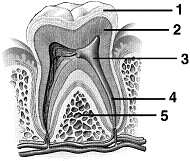What allows mammals to process a wider variety of foods than other vertebrates?
a. They have two types of teeth.
b. They have four types of teeth.
c. They have jaws.
d. They have larger mouths.
e. They have sharper teeth.
b
You might also like to view...
The life-cycle stages of the intestinal trematodes after the eggs are shed from the body via feces are best described as:
a. cercariae, miracidium larva, metacercariae, and redia. b. redia, metacercariae, cercariae, and mira-cidium larva. c. miracidium larva, redia, cercariae, and metacercariae. d. metacercariae, miracidium larva, cercariae, and redia.
The lumen of the digestive tract describes
a. the movement of food along its length. b. its outer covering. c. the space inside. d. muscular layers. e. the twisted path it follows through the abdomen.
In Figure 47-1, dentin is labeled as number:

a. 1
b. 2
c. 3
d. 4
e. 5
Much of the work of breaking down the food we ingest is done by our
(a) stomach (b) teeth (c) gut microbiome (d) esophagus